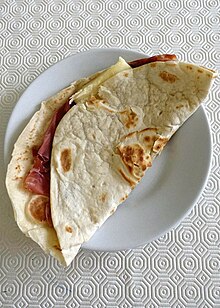This article needs additional citations for verification. (March 2017) |
You can help expand this article with text translated from the corresponding article in Italian. Click [show] for important translation instructions.
|
Piadina romagnola (Italian: [pjaˈdiːna]) or simply piadina, traditionally piada (Italian: [ˈpjaːda]), is a thin Italian flatbread, typically prepared in the Romagna historical region (Forlì, Cesena, Ravenna, and Rimini). It is usually made with white flour, lard or olive oil, salt, and water. The dough was traditionally cooked on a terracotta dish (called teggia or testo in Romagnol), although nowadays flat pans or electric griddles are commonly used.
 | |
| Alternative names | Piada |
|---|---|
| Type | Flatbread |
| Place of origin | Italy |
| Region or state | Romagna |
| Main ingredients | Flour, lard or olive oil, salt, water |
The piadina has been added to the list of the prodotti agroalimentari tradizionali (PAT) of the Emilia-Romagna region, and to the Protected Geographical Indication of the European Union in 2014[1]
Origin
editSince Ancient Rome flatbreads like this were used, the first mention of the piadina was in 1317,[2] in the Descriptio provinciæ Romandiolæ, when papal legate Angel de Grimoard describes it's recipe: "It's made with grain wheat mixed with water and seasoned with salt. It can also be made with milk and seasoned with a bit of lard".
Ancient versions of the piadina were made with poorer kinds of wheat, such as ones made with chestnut or acorns, especially in mountainous areas
Etymology
editThe etymology of the word piadina is uncertain; many think the term piada (piê, pièda, pìda) was borrowed from the Greek word for 'focaccia'. Others think the term was borrowed from other languages because of the large use of similar foods throughout the Eastern Roman Empire. The term piada was officialized by Giovanni Pascoli, who adapted the Romagnol word piè into its more Italian form.[3] Romagna was heavily influenced by Byzantium during the early Middle Ages, when the Eastern Empire reconquered parts of the Western domain which had fallen to the invading barbarians. In those days Ravenna was the capital city of the Exarchate, and that would explain how the Greco-Byzantine recipe entered the local gastronomy.
Modern era
editPiadine are usually sold immediately after preparation in specialised kiosks (called piadinerie), filled with a variety of cheeses, cold cuts and vegetables, but also with sweet fillings, including jam or Nutella. There may be small differences depending on the zone of production. Piadine produced around Ravenna and Forlì are generally thicker, while those produced around Rimini and the Marche region are thinner and the diameter is greater.
Piadina has even found its way to space, eaten by a Russian astronaut as part of a Mediterranean diet experiment on the International Space Station.[4]
| La j'è bona in tot i mud, la j'è bona énca scundida sa' n'avì ancora capì, a scor propri dla pida. |
Delicious with filling or even served plain, if you haven't already guessed, I am talking about the piadina. |
According to Giovanni Pascoli,
Nothing speaks more of Romagna than this bread of ours... it is a symbol that speaks of devotion to our land.
— Romagna Piadina: from tradition to flavour[3]
See also
edit- Piada dei morti – a sweet focaccia native to Rimini,[5][6] named after piadina for their shared circular shape[7]
References
edit- ^ Commission Implementing Regulation (EU) No 1174/2014 of 24 October 2014 entering a name in the register of protected designations of origin and protected geographical indications (Piadina Romagnola/Piada Romagnola (PGI))
- ^ "The story of the piadina romagnola". , on consorziopiadinaromagnola.it.
- ^ a b "Romagna Piadina: from tradition to flavour". Archived from the original on 22 July 2011. Retrieved 6 November 2024.
- ^ "Buon appetito: Russian cosmonauts on a Mediterranean diet". European Space Agency. 26 April 2004. Retrieved 4 June 2024.
- ^ Lazzari, Martina (29 October 2023). "Piada dei morti, preparazione e curiosità sulla dolce "piadina" romagnola" [Piada dei morti: Preparation and curiosity about the sweet Romagnol "piadina"]. RiminiToday (in Italian). Retrieved 17 February 2024.
- ^ Santini, Enrico (29 October 2023). "La Piada dei Morti di Rimini, qual è la migliore?" [Rimini's piada dei morti: Which is the best?]. Chiamami Città (in Italian). Retrieved 17 February 2024.
- ^ Succi, Margherita. "Tra mosto e frutta secca, a novembre arriva la piada dei morti" [Between must and dried fruit, the piada dei morti arrives in November]. Hotel Corallo Rimini (in Italian). Retrieved 17 February 2024.
External links
edit- (in Italian) PiadinaOnLine
- (in Italian) Tracce di storia della piada